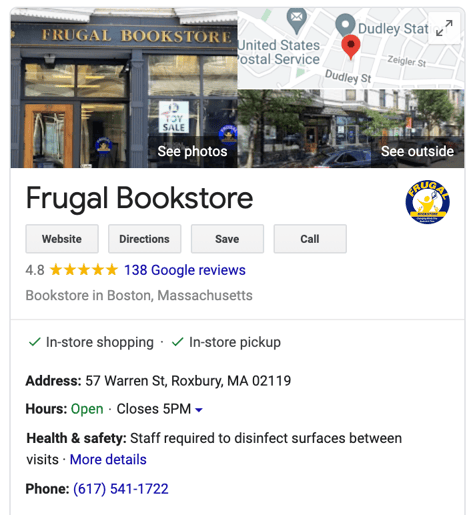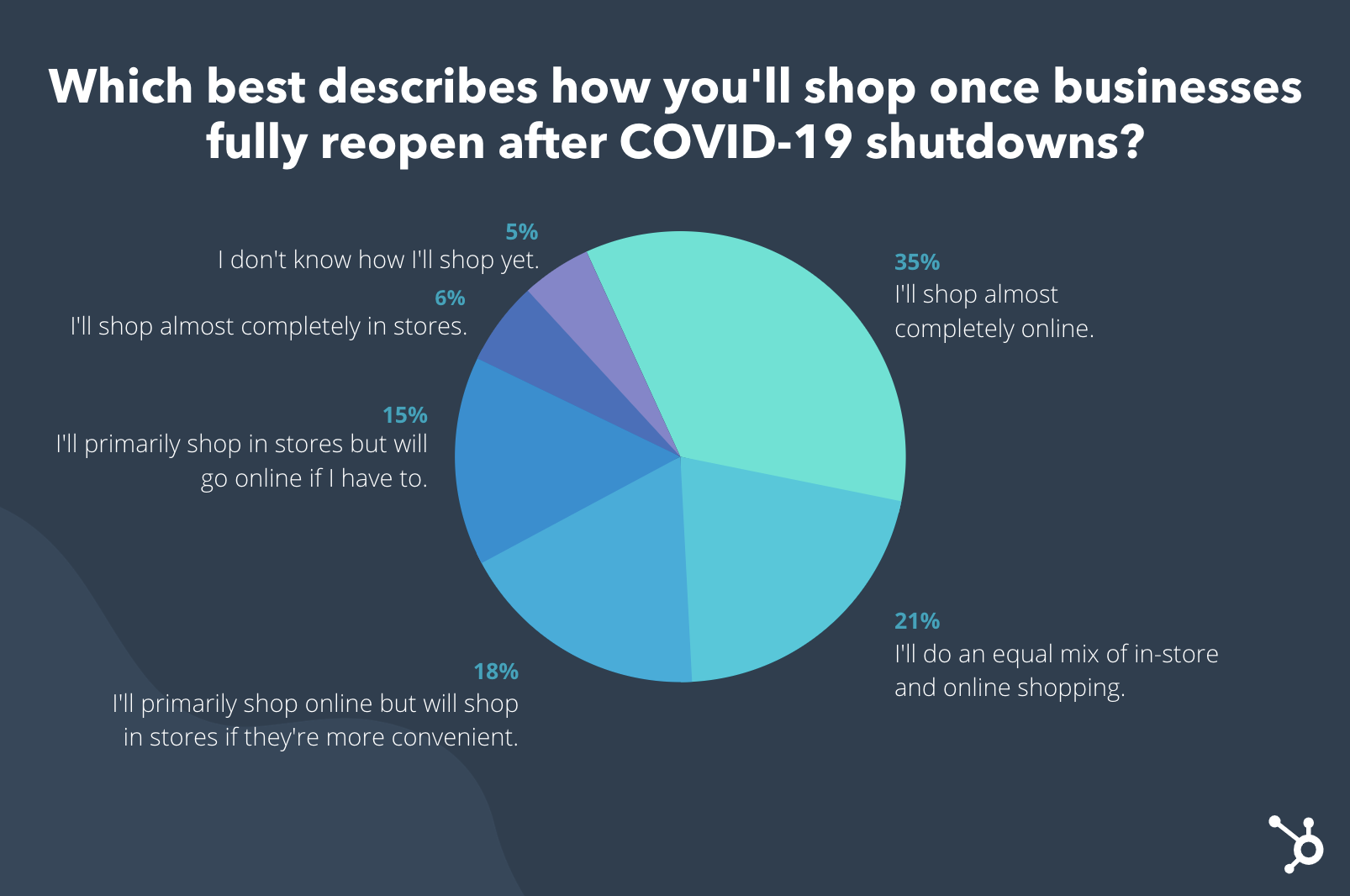For the last year and a half, many of us have gotten used to doing everything -- including shopping -- from home.
Now, it seems full reopenings are closer than ever in the U.S. as the CDC now says that fully vaccinated Americans no longer need to wear masks or social distance unless there is a federal, state, local, workplace, or tribal mandate requiring them to.
But as cities, offices, stores, and restaurants reopen to full capacity, many of us are beginning to think about how life will be after the global pandemic ends.
As an individual, a post-pandemic world might be quite exciting to think about. But, as a marketer, entrepreneur, or manager, you might be wondering, "Will shopping go back to normal after reopenings?"
To help brands in the U.S. navigate and plan for reopenings, we used Lucid to ask more than 300 North American consumers, "Which best describes how you'll shop once businesses fully reopen after COVID-19 shutdowns?"
The results might or might not surprise you.
Just over one-third, or 35% of respondents say they'll "shop almost completely online." Meanwhile, 21% predict they'll do an even mix of online and in-store shopping, while 18% will primarily shop online but go to stores when they're convenient.
If you've built a strong brick-and-mortar brand, don't panic. First of all, this is just one general consumer survey with a small pool of respondents. Additionally, aside from the respondents who plan to do a mix of online and in-store shopping, 21% of respondents plan to shop primarily or completely in physical stores after economies fully reopen. Had we asked about specific products or polled people in another country, the results might have been different.
While this is just one data point to think about, it's worth noting because it shows that there will likely be a strong interest in online shopping -- even when every physical store re-opens to full capacity.
So, how can you navigate changing future shopping behaviors? Whether you run or work for an online or physical business, here are a few tactics to embrace.
How to Reach Shoppers After Reopenings
1. Launch or expand on your website.
Even if you can't launch a robust online store yet, a basic website can allow potential customers to discover you online, learn more about your business, and find your contact information.
Once you have a basic website that explains what your brand does, how they can reach you, and where you're located, you can continue to optimize it for audiences by adding:
- Pricing pages that explain the price range for each of your services or higher-priced products.
- Images or videos of your team providing a service, your store, new products people can find there, or customers who consent to be featured on your site.
- A few blog posts that give more information about your brand, topics related to your brand, or tips related to your industry. For example, if you sell construction products, your blogs could give people tips for simple fixes they can make at home without needing to hire a professional.
- A landing page or contact form where people can contact you for more information, a product demo, or to schedule a service.
For more about what audiences look for when they visit a business's website, check out this data-filled blog post.
2. Consider adding online shopping or ordering options.
Not a tech-savvy web expert who can create their own online store quickly? That's okay, If you'd like to explore selling products online, there are still tools that can help you,
During COVID-19, many online shopping platforms emerged to help brands sell products or services online. While many restaurants began to leverage delivery or pick-up order apps, small stores and boutiques could build stores with tools like Shopify, Facebook Shops, and Instagram Shops.
But, although having an online store might be a great idea, it does pose its challenges. For example, you'll want to make sure your shipping and delivery strategy is ready for online orders so you don't sell out if a product or service is very popular. You'll also still need to spend some time putting product shots, descriptions, and your store's basic design together.
If you're not ready for an online store or service just yet and want to continue to vet the idea, you can keep reading for other tips that don't require a full ecommerce experience. If you're ready to launch your first online store, check out our Ultimate Guide to Ecommerce.
3. Embrace online marketing.
Even if you don't have an online store, you should still consider leveraging social media, review sites, and email marketing to spread the word about your business online.
If you're completely new to the world of web marketing, a great place to start is by setting up a free Google My Business profile. This will allow your business's name, address, details, website, and reviews to show up when people are looking for products or services you sell in your area.
 From there, you can also consider venturing on to review sites like Yelp, while encouraging happy customers to give you reviews there.
From there, you can also consider venturing on to review sites like Yelp, while encouraging happy customers to give you reviews there.
If you've already taken the steps above, the next places to embrace will likely be social media and email marketing. Through these channels, you can let customers know about sales or new offerings, send them helpful content related to your brand, or share happy customer stories. This way, even if you don't have an online store, people will be able to gain awareness for your brand on the web.
4. Immerse your audience in virtual experiences.
During the early days of shutdowns, we saw a handful of physical brands come up with ways to bring virtual experiences or product offerings to their audiences and customers.
For example, Planet Fitness offered gym members videos from personal trainers, hair studios guided customers as they gave themselves haircuts over video calls, and petting zoo patrons could pay for animals to attend their conference calls.
There are plenty of creative ways to bring virtual experiences to your audiences. And, while you can't always charge for them, they could certainly grow your online awareness and help more prospective customers learn about your brand and physical store.
5. Prepare your physical business for new shopping behaviors.
Although we'd love to imagine the world going completely "back to normal" overnight, this will still take time. People will likely continue to remain cautious even if they're vaccinated and their state is loosening regulations.
For example, vaccinated Americans will soon be able to take off masks inside and outside establishments, customers will likely still want to see that businesses are making efforts to keep them safe. In 2020, a 2020 McKinsey Report suggests just this as many consumers said they are more likely to buy from companies that show care for their customers.
With data like McKinsey's, you'll still want to take some precautions by keeping your physical location clean and following the most updated CDC guidelines -- which can be found here.
Aside from getting your business ready for health-conscious customers, you'll also want to zone into strategies you can use to make it convenient for customers.
As we saw in our consumer poll above, 18% -- or almost one-fifth of our survey pool -- said "I'll primarily shop online but will shop in stores if they're more convenient." This means that if you have products or services that aren't easily accessible or often sold out online, you might earn customers that would have otherwise shopped on the web.
The data above could be good to think about as you determine which services, products, or sales you'll market when you fully reopen. If there's something shoppers can get in-store that they couldn't get online -- like a product, in-person testing, or another interesting experience, be sure to tell your audiences that.
Diving into Digital Transformation
Because the global pandemic has accelerated many digital transformations that were already underway, it's essential to embrace at least some digital strategies when running or marketing a brand -- even if it is brick-and-mortar.
Luckily, because so many businesses are pivoting to digital tactics, there are plenty of free or affordable tools that can help you embrace online marketing.
Aside from tools, HubSpot also offers a handful of free downloadable templates and resources for marketers or entrepreneurs at every level, like the one featured below.
from Marketing https://blog.hubspot.com/marketing/where-will-people-shop-when-businesses-reopen
For the last year and a half, many of us have gotten used to doing everything -- including shopping -- from home.
Now, it seems full reopenings are closer than ever in the U.S. as the CDC now says that fully vaccinated Americans no longer need to wear masks or social distance unless there is a federal, state, local, workplace, or tribal mandate requiring them to.
But as cities, offices, stores, and restaurants reopen to full capacity, many of us are beginning to think about how life will be after the global pandemic ends.
As an individual, a post-pandemic world might be quite exciting to think about. But, as a marketer, entrepreneur, or manager, you might be wondering, "Will shopping go back to normal after reopenings?"
To help brands in the U.S. navigate and plan for reopenings, we used Lucid to ask more than 300 North American consumers, "Which best describes how you'll shop once businesses fully reopen after COVID-19 shutdowns?"
The results might or might not surprise you.
Just over one-third, or 35% of respondents say they'll "shop almost completely online." Meanwhile, 21% predict they'll do an even mix of online and in-store shopping, while 18% will primarily shop online but go to stores when they're convenient.
If you've built a strong brick-and-mortar brand, don't panic. First of all, this is just one general consumer survey with a small pool of respondents. Additionally, aside from the respondents who plan to do a mix of online and in-store shopping, 21% of respondents plan to shop primarily or completely in physical stores after economies fully reopen. Had we asked about specific products or polled people in another country, the results might have been different.
While this is just one data point to think about, it's worth noting because it shows that there will likely be a strong interest in online shopping -- even when every physical store re-opens to full capacity.
So, how can you navigate changing future shopping behaviors? Whether you run or work for an online or physical business, here are a few tactics to embrace.
How to Reach Shoppers After Reopenings
1. Launch or expand on your website.
Even if you can't launch a robust online store yet, a basic website can allow potential customers to discover you online, learn more about your business, and find your contact information.
Once you have a basic website that explains what your brand does, how they can reach you, and where you're located, you can continue to optimize it for audiences by adding:
- Pricing pages that explain the price range for each of your services or higher-priced products.
- Images or videos of your team providing a service, your store, new products people can find there, or customers who consent to be featured on your site.
- A few blog posts that give more information about your brand, topics related to your brand, or tips related to your industry. For example, if you sell construction products, your blogs could give people tips for simple fixes they can make at home without needing to hire a professional.
- A landing page or contact form where people can contact you for more information, a product demo, or to schedule a service.
For more about what audiences look for when they visit a business's website, check out this data-filled blog post.
2. Consider adding online shopping or ordering options.
Not a tech-savvy web expert who can create their own online store quickly? That's okay, If you'd like to explore selling products online, there are still tools that can help you,
During COVID-19, many online shopping platforms emerged to help brands sell products or services online. While many restaurants began to leverage delivery or pick-up order apps, small stores and boutiques could build stores with tools like Shopify, Facebook Shops, and Instagram Shops.
But, although having an online store might be a great idea, it does pose its challenges. For example, you'll want to make sure your shipping and delivery strategy is ready for online orders so you don't sell out if a product or service is very popular. You'll also still need to spend some time putting product shots, descriptions, and your store's basic design together.
If you're not ready for an online store or service just yet and want to continue to vet the idea, you can keep reading for other tips that don't require a full ecommerce experience. If you're ready to launch your first online store, check out our Ultimate Guide to Ecommerce.
3. Embrace online marketing.
Even if you don't have an online store, you should still consider leveraging social media, review sites, and email marketing to spread the word about your business online.
If you're completely new to the world of web marketing, a great place to start is by setting up a free Google My Business profile. This will allow your business's name, address, details, website, and reviews to show up when people are looking for products or services you sell in your area.
 From there, you can also consider venturing on to review sites like Yelp, while encouraging happy customers to give you reviews there.
From there, you can also consider venturing on to review sites like Yelp, while encouraging happy customers to give you reviews there.
If you've already taken the steps above, the next places to embrace will likely be social media and email marketing. Through these channels, you can let customers know about sales or new offerings, send them helpful content related to your brand, or share happy customer stories. This way, even if you don't have an online store, people will be able to gain awareness for your brand on the web.
4. Immerse your audience in virtual experiences.
During the early days of shutdowns, we saw a handful of physical brands come up with ways to bring virtual experiences or product offerings to their audiences and customers.
For example, Planet Fitness offered gym members videos from personal trainers, hair studios guided customers as they gave themselves haircuts over video calls, and petting zoo patrons could pay for animals to attend their conference calls.
There are plenty of creative ways to bring virtual experiences to your audiences. And, while you can't always charge for them, they could certainly grow your online awareness and help more prospective customers learn about your brand and physical store.
5. Prepare your physical business for new shopping behaviors.
Although we'd love to imagine the world going completely "back to normal" overnight, this will still take time. People will likely continue to remain cautious even if they're vaccinated and their state is loosening regulations.
For example, vaccinated Americans will soon be able to take off masks inside and outside establishments, customers will likely still want to see that businesses are making efforts to keep them safe. In 2020, a 2020 McKinsey Report suggests just this as many consumers said they are more likely to buy from companies that show care for their customers.
With data like McKinsey's, you'll still want to take some precautions by keeping your physical location clean and following the most updated CDC guidelines -- which can be found here.
Aside from getting your business ready for health-conscious customers, you'll also want to zone into strategies you can use to make it convenient for customers.
As we saw in our consumer poll above, 18% -- or almost one-fifth of our survey pool -- said "I'll primarily shop online but will shop in stores if they're more convenient." This means that if you have products or services that aren't easily accessible or often sold out online, you might earn customers that would have otherwise shopped on the web.
The data above could be good to think about as you determine which services, products, or sales you'll market when you fully reopen. If there's something shoppers can get in-store that they couldn't get online -- like a product, in-person testing, or another interesting experience, be sure to tell your audiences that.
Diving into Digital Transformation
Because the global pandemic has accelerated many digital transformations that were already underway, it's essential to embrace at least some digital strategies when running or marketing a brand -- even if it is brick-and-mortar.
Luckily, because so many businesses are pivoting to digital tactics, there are plenty of free or affordable tools that can help you embrace online marketing.
Aside from tools, HubSpot also offers a handful of free downloadable templates and resources for marketers or entrepreneurs at every level, like the one featured below.



No hay comentarios:
Publicar un comentario